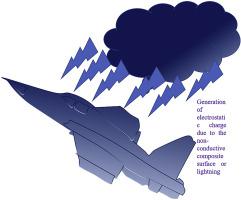Defence Technology ( IF 5.0 ) Pub Date : 2019-04-16 , DOI: 10.1016/j.dt.2019.04.008 Ramdayal Yadav , Manoj Tirumali , Xungai Wang , Minoo Naebe , Balasubramanian Kandasubramanian

|
The phenomenon of static electricity is unpredictable, particularly when an aircraft flying at high altitude that causes the accumulation of static charges beyond a threshold value leading to the failure of its parts and systems including severe explosion and radio communication failure. The accumulation of static charges on aircraft is generated by the virtue of interaction between the outer surface of aircraft and the external environmental attributes encompasses air particles, ice, hail, dust, volcanic ash in addition to its triboelectric charging. In the recent years, advanced polymer-based composites or nanocomposites are preferred structural constituents for aircrafts due to their light weight and comparable mechanical properties, but such composite systems do not render low impedance path for charge flow and are subsequently vulnerable to effect of lightning strike and precipitation static. In this context, it is essential to develop conductive composite systems from non-conductive polymer matrix by nanofiller embodiments. The advent of carbon-based nanocomposite/nanomaterials have adequately addressed such issues related to the nonconductive polymer matrix and further turned into an avant-garde genre of materials. The current review envisioned to illustrate the detailed exploitation of various polymer nanocomposites in addition to especially mentioned epoxy composites based on carbon fillers like carbon black, carbon nanotube (single walled carbon nanotube and multi walled carbon nanotube) and graphene the development of antistatic application in aircraft in addition to the static charge phenomenon and condition for its prevalence in avionic systems.
中文翻译:

航空航天抗静电应用的聚合物复合材料
静电现象是无法预测的,特别是当飞机在高空飞行而导致静电荷积聚超过阈值而导致其零件和系统出现故障(包括严重爆炸和无线电通信故障)时,尤其如此。飞机上静电荷的积累是由于飞机外表面之间的相互作用而产生的,外部环境属性除其摩擦带电外还包括空气颗粒,冰,冰雹,灰尘,火山灰。近年来,先进的聚合物基复合材料或纳米复合材料因其重量轻和可比的机械性能而成为飞机的首选结构成分,但是这种复合系统不会为电荷流提供低阻抗路径,因此容易受到雷击和静电沉淀的影响。在本文中,通过纳米填料实施方案由非导电聚合物基质开发导电复合体系是必不可少的。碳基纳米复合材料/纳米材料的出现已充分解决了与非导电聚合物基体有关的此类问题,并进一步成为材料的先锋派。当前的审查旨在说明除特别提到的基于碳填料(如炭黑)的环氧复合材料外,各种聚合物纳米复合材料的详细开发,











































 京公网安备 11010802027423号
京公网安备 11010802027423号